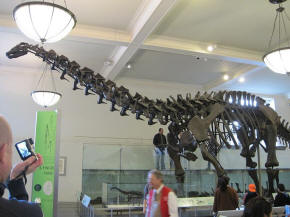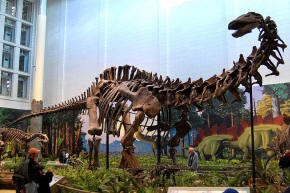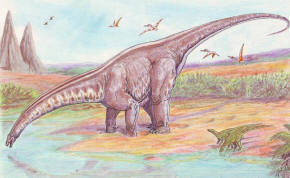|
The cervical vertebrae were less
elongated and more heavily constructed than those of
Diplodocus and the bones
of the leg were much stockier (despite being longer), implying a more robust
animal. The tail was held above the ground during normal locomotion. Like
most sauropods, Apatosaurus
had only a single large claw on each forelimb, with the first three toes on
the hind limb possessing claws.
Fossils of these animals have been
found in
Nine Mile Quarry and
Bone Cabin Quarry in
Wyoming and at sites in
Colorado,
Oklahoma and Utah.
Description
Apatosaurus
was a large, long-necked quadrupedal animal with
a long, whip-like tail. Its forelimbs were slightly shorter than its
hindlimbs. One measurement places the total length of the species
Apatosaurus louisae at
22 m (72 ft).
It was roughly the weight of four
elephants.
One specimen of A. excelsus
was estimated to weigh 25,952 kg (57,210 lb);
estimates for A. louisae
were 20,600 kg (45,000 lb)
and 22,407 kg (49,400 lb).
Other estimates of the body mass of adult
Apatosaurus species range from 18,000 kg (40,000
lb)
to 35,000 kg (77,000 lb).
A microscopic study of Apatosaurus
bones concluded that the animals grew rapidly when young and reached
near-adult sizes in about 10 years.
The skull was small in comparison
with the size of the animal. The jaws were lined with spatulate teeth, which
resembled chisels, suited to an herbivorous diet. Like other sauropods, the
vertebrae of the neck were deeply bifurcated; that is, they carried paired
spines, creating a wide and deep profile for the neck.
The apparently massive neck was, however, filled with an extensive system of
weight-saving air sacs. Apatosaurus,
like its close relative
Supersaurus, is notable for the incredibly
tall spines on its vertebrae, which make up more than half the height of the
individual bones. Also unusual among diplodocids is the shape of the tail,
which is comparatively thin in breadth and short in height, a profile caused
by the vertebral spines decreasing in height rapidly the farther they are
from the hips. Apatosaurus
also had very long ribs compared to most other diplodocids, giving it an
unusually deep chest. The limb bones were also very robust.
Classification and species
Apatosaurus
is a member of the family
Diplodocidae, a
clade of gigantic
sauropod
dinosaurs. The family
includes some of the longest creatures ever to walk the earth, including
Diplodocus,
Supersaurus,
Suuwassea, and
Barosaurus. Within the subfamily
Apatosaurinae, Apatosaurus
may be most closely related to Suuwassea,
Supersaurus and
Eobrontosaurus.
In 1877,
Othniel Charles Marsh
published the name of the
type species
Apatosaurus ajax.
He followed this in 1879 with a description of another, more complete
specimen, which he thought represented a new genus
and species, which he named
Brontosaurus excelsus.
In 1903,
Elmer Riggs re-examined
the fossils. While he agreed with Marsh that
Brontosaurus excelsus was likely a distinct
species, he also noted many similarities between
B. excelsus and
A. ajax, and decided that
both should be placed in the same genus. Riggs re-classified the species as
Apatosaurus excelsus.
Almost all paleontologists since Riggs published his opinions have agreed
that the two species should be classified together in a single genus.
According to the rules of the
ICZN (which governs the
scientific names of animals), the name
Apatosaurus, having been published first, had
priority as the official name; Brontosaurus
is considered a
junior synonym and has
therefore been discarded from formal use.
| Diplodocidae |
|
| Apatosaurinae |
|
|
| Diplodocinae |
|
|
|
|
|
|
Cladogram of the Diplodocidae after Lovelace, Hartman, and Wahl,
2008. |
|
Apatosaurus ajax
is the type species of the
genus, and was named by the paleontologist
Othniel Charles Marsh
in 1877 after Ajax, the hero
from Greek mythology. It is
the
holotype for the genus
and two partial skeletons have been found, including part of a skull.
Apatosaurus excelsus
(originally Brontosaurus)
was named by Marsh in 1879. It is known from six partial skeletons,
including part of a skull, which have been found in the
United States, in
Colorado,
Oklahoma, Utah,
and Wyoming.
Apatosaurus louisae was
named by William Holland in 1915 in honor of Mrs. Louise Carnegie, wife of
Andrew Carnegie who
funded field research to find complete dinosaur skeletons in the American
West. Apatosaurus louisae
is known from one partial skeleton which was found in Utah
in the United States.
Apatosaurus parvus
was originally known as Elosaurus parvus,
but was reclassified as a species of
Apatosaurus in 1994.
Apatosaurus yahnahpin
was named by Filla and Redman in 1994.
Robert T. Bakker made
A. yahnahpin the
type species of a new
genus,
Eobrontosaurus in
1998,
so it is now properly Eobrontosaurus yahnahpin.
One partial skeleton has been found in Wyoming. It has been argued that
Eobrontosaurus
belongs within
Camarasaurus,
although this has been questioned.
History
Othniel Charles Marsh,
a Professor of Paleontology at
Yale University, described and
 |
| Apatosaurus excelsus at the American Museum of Natural
History (Picture
Source) |
named an
incomplete (and juvenile) skeleton of
Apatosaurus ajax in 1877. Two years later, Marsh
announced the discovery of a larger and more complete specimen at
Como
Bluff
Wyoming—which, because
of discrepancies including the size difference, Marsh incorrectly identified
as belonging to an entirely new genus
and species. He dubbed the
new species Brontosaurus excelsus,
meaning "thunder lizard", from the Greek
brontē/βροντη
meaning 'thunder' and sauros/σαυρος
meaning 'lizard', and from the Latin
excelsus, "highest,
sublime", referring to the greater number of sacral vertebrae than in any
other genus of sauropod known at the time.
The finds—the largest dinosaur ever
discovered at the time and nearly complete, lacking only a head, feet, and
portions of the tail — were then prepared for what was to be the first ever
mounted display of a sauropod skeleton, at Yale's
Peabody Museum of Natural History
in 1905. The missing bones were created using known pieces from close
relatives of Brontosaurus.
Sauropod feet that were discovered at the same quarry were added, as well as
a tail fashioned to appear as Marsh believed it should, as well as a
composite model of what he felt the skull of this massive creature might
look like. This was not a delicate
Diplodocus-style skull (which would later
turn out to be more accurate),
but was composed of "the biggest, thickest, strongest skull bones, lower
jaws and tooth crowns from three different quarries",
primarily those of
Camarasaurus, the only other sauropod for
which good skull material was known at the time. This method of
reconstructing incomplete skeletons based on the more complete remains of
related dinosaurs continues in museum mounts and life restorations to this
day.
Despite the much-publicized debut of
the mounted skeleton, which cemented the name
Brontosaurus in the public consciousness, Elmer Riggs had
published a paper in the 1903 edition of
Geological Series of the Field Columbian Museum
which argued that Brontosaurus
was not different enough from Apatosaurus
to warrant its own genus, and created the combination
Apatosaurus excelsus: "In
view of these facts the two genera may be regarded as synonymous. As the
term 'Apatosaurus' has priority, 'Brontosaurus' will be regarded as a
synonym."
Despite this, at least one
paleontologist—Robert
Bakker—argued in the 1990s that
A. ajax and
A. excelsus are in fact
sufficiently distinct that the latter continues to merit a separate genus.
This idea has not been accepted by many palaeontologists.
Palaeobiology
Early on, it was believed that
Apatosaurus was too
massive to support its own weight on dry land, so it was theorized that the
sauropod must have lived partly submerged in water, perhaps in a swamp.
Recent findings do not support this. In fact, like its relative
Diplodocus,
Apatosaurus was a grazing
animal with a very long neck and a long tail that served as a counterweight.
One study suggested that diplodocid necks were less flexible than previously
believed, and that sauropods like
Apatosaurus
were adapted to low browsing or ground feeding.
In 2008, footprints of juvenile
Apatosaurus were
reported from Quarry Five in Morrison, Colorado. Discovered in 2006 by
Matthew Mossbrucker, these footprints show that juveniles could run on their
hind legs in a manner similar to that of the modern
basilisk lizard.
Apatosaurus
was the second most common sauropod in the
Morrison Formation
ecosystem, after
Camarasaurus.
It may have been a more solitary animal than other Morrison Formation
dinosaurs.
As a genus, Apatosaurus
existed for a long span of time, and have been found in most levels of the
Morrison. Fossils of Apatosaurus ajax
are known exclusively from the upper portion of the formation (upper Brushy
Basin Member), about 152-151 million years ago.
A. excelsus fossils have
been reported from the upper Salt Wash Member to the upper Brushy Basin
Member, ranging from the middle to late
Kimmeridgian age, about 154-151 million
years ago. A. louisae
fossils are rare, known only from one site in the upper Brushy Basin Member,
dated to the late Kimmeridgian stage (about 151 million years ago).
Additional Apatosaurus
remains are known from even younger rocks, but they have not been identified
as any particular species.
Posture
In the early 20th century, diplodocids like
Apatosaurus were often
portrayed with their necks held high up in the air, allowing them to graze
from tall trees. More recently, scientists have argued that the heart would
have had trouble sustaining sufficient blood pressure to oxygenate the
brain. Furthermore, more recent studies have shown that the structure of the
neck vertebrae would not have permitted the neck to bend far upwards.
However, subsequent studies demonstrated that all
tetrapods appear to
hold their necks at the maximum possible vertical extension when in a
normal, alert posture, and argued that the same would hold true for
sauropods barring any unknown, unique characteristics that set the soft
tissue anatomy of their necks apart from other animals.
Apatosaurus, like
Diplodocus, would have
held its neck angled upward with the head pointed downwards in a resting
posture.
Physiology
Given the large body mass of
Apatosaurus, combined with
its long neck, physiologists have
encountered problems determining how these animals managed to breathe.
Beginning with the assumption that
Apatosaurus, like
crocodilians, did not
have a diaphragm, the
dead-space volume (the
amount of unused air remaining in the mouth, trachea and air tubes after
each breath) has been estimated at about 184 liters for a 30 ton specimen.
Its
tidal volume (the
amount of air moved in or out during a single breath) has been calculated
based on the following
respiratory systems:
 |
904 liters if avian
|
 |
225 liters if mammalian
|
 |
19 liters if reptilian.
|
On this basis, its respiratory system
could not have been reptilian, as its tidal volume would not have been able
to replace its dead-space volume. Likewise, the mammalian system would only
provide a fraction of new air on each breath. Therefore, it must have had
either a system unknown in the modern world or one like birds, i.e. multiple
air sacs and a flow-through lung. Furthermore, an avian system would only
need a lung volume of about 600 liters compared to a mammalian requirement
of 2,950 liters, which would exceed the available space. The overall
thoracic volume of
Apatosaurus
has been estimated at 1,700 liters allowing for a 500-liter, four-chambered
heart (like birds, not
three-chambered like reptiles) and a
900-liter lung capacity. That would allow about 300 liters for the necessary
tissue. Assuming
Apatosaurus had an avian
respiratory system and a reptilian resting-metabolism, it would need to
consume only about 262 liters (69 gallons) of water per day.
Tail
An article that appeared in the
November 1997 issue of
Discover Magazine
reported research into the mechanics of
Apatosaurus tails by
Nathan Myhrvold, a computer scientist from
Microsoft. Myhrvold
carried out a computer simulation of
the tail, which in diplodocids like
Apatosaurus
was a very long, tapering structure resembling a
bullwhip. This computer modeling suggested
that sauropods were capable of producing a whip-like cracking sound of over
200 decibels
comparable to the volume of a cannon.
In popular
culture
The length of time taken for Marsh's
misclassification to be brought to public notice meant that the name
Brontosaurus, associated
as it was with one of the largest dinosaurs, became so famous that it
persisted long after the name had officially been abandoned in scientific
use.
As late as 1989, the U.S. Post Office issued
four "dinosaur" stamps,
Tyrannosaurus,
Stegosaurus,
Pteranodon (which is a
pterosaur and not a dinosaur) and
Brontosaurus. The
inclusion of these last two led to complaints of "fostering scientific
illiteracy."
The Post Office defended itself (in Postal Bulletin 21744) by saying,
"Although now recognized by the scientific community as
Apatosaurus, the name
'Brontosaurus' was used for the stamp because it is more familiar to the
general population."
Stephen Jay Gould
supported this position in his essay "Bully
for Brontosaurus", though he echoed Riggs'
original argument that Brontosaurus
is a synonym for Apatosaurus.
Nevertheless, he noted that the former has developed and continues to
maintain an independent existence in the popular imagination.
Brontosaurus
has often been depicted in cinema, beginning with Winsor McKay's 1914
classic
Gertie the Dinosaur.
The 1925 silent film
The Lost World
featured, using special effects by
Willis O'Brien, a
battle between a
Brontosaurus
and an
Allosaurus,
but the former inaccurately had a very bendy neck. When
George Lucas made his special edition of
Star Wars Episode IV: A New Hope
in 1997, he added some large, long-necked animals based on the
Brachiosaurus digital model from the earlier
film
Jurassic Park. At an
early stage he altered the CG department's suggested name "Bronto", taken
from Brontosaurus,
to 'Ronto'.
Sinclair Oil has a long
history of being a fixture on American roads (and briefly in other
countries) with its green dinosaur logo and mascot, an
Apatosaurus (Brontosaurus).
While Sinclair's early advertising included a number of different dinosaurs,
eventually only Apatosaurus
was used as the official logo, due to its popular appeal.
The
Brontosaurus is the main plot focus of the 1985
movie
Baby: Secret of the Lost Legend,
in which a family of Brontosaurs
are found still living in Africa.
Return to the
Old Earth Ministries Online Dinosaur
Curriculum homepage.

Shopping
Bay
State Replicas - 1/12th scale skeleton, Vertebra, two femers, scapula
Black
Hills Institute - Baby skeleton, baby skeleton in matrix
|



